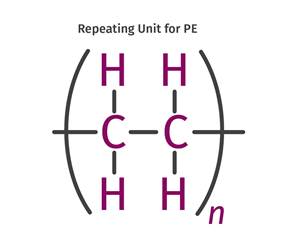New Irradiated Polyethylenes Boost Processing and Performance
For decades, makers of polyethylene wire and cable, shrink tubing, hot and cold water piping, sheet, and foam have used radiation crosslinking to enhance the thermal and mechanical properties of their products.
This novel approach is being taken by Sterigenics International, which claims to be the world’s largest provider of contract radiation services, with 17 plants in North America and three in Europe and Asia. After several years of processing pellets for individual customers, Sterigenics came out with its Raprex brand of HDPE and LLDPE pellets in 2004.
According to Lew is A. Parks, v.p. of Sterigenics Advanced Applications, the company initially thought pro cessors would buy PE resins and send them for toll processing by Sterigenics for around 5¢ to 25¢/lb. But processors showed more enthusiasm for buying pretreated pellets that came with datasheets of specified properties.
Demand has taken off so successfully, says Raprex product manager George Forczek, that Sterigenics is expanding its capacity to handle larger orders. The company has dedicated a facility for irradiating pellets at Gaithersburg, Md. Available to begin processing in the first half of this year, it will accommodate truckload orders initially and railcar quantities later on. Throughput rates will be up to 20,000 lb/hr. Forczek envisions multi-million-pound annual sales of Raprex within the next few years. Beyond polyolefins, other radiation-modified thermoplastics are in development.
What radiation provides
Sterigenics uses gamma and electron-beam (EB) radiation to modify polyethylene. According to Parks, the “recipe” for Raprex products includes selecting the proper PE base resin (with special attention to additives), choosing the type and dosage of radiation, and compounding stabilizers and other additives after radiation. Radiation treatment provides three effects:
- Increased chain branching and broader molecular-weight distribution.
- Oxidation, which adds polar end groups to the base polymer.
- A low degree of crosslinking, which does not harm recyclability.
These radiation effects produce three main benefits: First, processability is enhanced because viscosity is increased at lower shear rates. That means greater melt strength (handy for extrusion) without greater flow resistance (good for molding).
Second, polar end groups provide better adhesion to metal for pipe coating and to fillers like wood flour.
Third, a variety of benefits derive from improved end-use properties such as mechanical strength, toughness, wear resistance, ESCR, HDT, flame resistance, and heat-sealability.
Sterigenics offers three grades for injection molding and extrusion:Third, a variety of benefits derive from improved end-use properties such as mechanical strength, toughness, wear resistance, ESCR, HDT, flame resistance, and heat-sealability.
- Raprex 100 extrusion-grade HDPE is aimed particularly at water and pressure pipe, as well as profiles. It boasts higher stiffness, burst and hoop strengths, and ESCR.
- Raprex 200 HDPE for injection molding has better strength, toughness, heat resistance, and flame resistance.
- Raprex 300 LLDPE for blown film has higher tear and puncture strengths. It is aimed at mono- and multi-layer greenhouse film, geomembranes, and industrial liners or covers.
Other service providers
Probably the oldest and best-known U.S. name in radiation modification of plastics is E-Beam Services, formerly the radiation processing unit of Monsanto. The company has three facilities in New Jersey, Ohio, and Indiana. John Messick, national sales manager, says the firm processes millions of pounds per year of pellets on a toll basis for resin producers and a couple of processors that mold filter elements. E-Beam also treats finished products such as gaskets, pipe, tubing, or sheet. He says upgrading heat resistance is the most common goal sought from radiation modification.
A large supplier of contract sterilization, with at least a dozen radiation-processing facilities, is Steris Isomedix Services. At its EB facility in Libertyville, Ill., the firm modifies plastic pellets and parts (wire, cable, and tubing). EB sales application specialist Chad Rhodes says Steris provides toll treatment of HDPE, LDPE, and EVA pellets for resin companies and a few end users.
TABLE 1—RAPREX 100 IRRADIATED HDPE FOR PIPE (12.8 mm Diam., 1.9 mm Wall) | |
| Density, g/cc | 0.950 |
| Melt Index, g/10 min 190 C, 21.6 kg | 3.5 |
| Tensile Strength, psi Yield Break | 4350 3973 |
| Elongation @ Break, % | 506 |
| Flex. Strength, psi 212 F -40 F | 1454 1380 |
| Burst Strength, psi 73 F 212 F | 1412 660 |
| Hoop Strength, psi 73 F 212 F | 4046 1885 |
| Impact Strength 73 F 40 F Aged @ 257 F | No Cracking No Cracking No Cracking |
| Stress Cracking, psi @ 140 F | 1431 |
| Chemical Resistance Ethanol (200 hr) Battery Acid ( 70 hr) Oil (70 hr, 212 F), % Change | No Cracking No Cracking 3.98 |
TABLE 2—RAPREX 200 R-200C1 IRRADIATED HDPE FOR INJECTION MOLDING | ||
| Property | Non-Irradiated | Irradiated |
| Density, g/cc | 0.952 | 0.950 |
| MFR, g/10 min 190 C, 2.16 kg 190 C, 10 kg | 0.75 — | <0.10 1.10 |
| Tensile Strength, psi Yield Break | 4200 1880 | 5650 3040 |
| Elongation, % Yield Break | 8 106 | 9 20 |
| Flex Modulus, psi | — | 2465 |
| Notched Izod Impact, kJ/m2 | 50/No Break | 54/No Break |
| HDT, F @ 66 psi | 165 | 189 |
IRRADIATED LLDPE FOR BLOWN FILM
(25-Micron Film)Property Non-Irradiated Irradiated MFR, g/10 min
190 C, 2.16 kg
190 C, 10 kg
1.01
7.69
0.20
3.46Tensile Strength, psi
Yield MD
Yield TD
Break MD
Break TD
1421
1189
5133
4046
2567
2045
7366
6670Ult. Elongation, %
MD
TD
600
710
750
790Tear Str., g/micron
MD
TD
7.0
7.7
12.2
13.4Puncture Str., g 481 921 HDT, F @ 66 psi 109 109
Related Content
Delivering Increased Benefits to Greenhouse Films
Baystar's Borstar technology is helping customers deliver better, more reliable production methods to greenhouse agriculture.
Read MorePolyethylene Fundamentals – Part 4: Failed HDPE Case Study
Injection molders of small fuel tanks learned the hard way that a very small difference in density — 0.6% — could make a large difference in PE stress-crack resistance.
Read MoreThe Fundamentals of Polyethylene – Part 2: Density and Molecular Weight
PE properties can be adjusted either by changing the molecular weight or by altering the density. While this increases the possible combinations of properties, it also requires that the specification for the material be precise.
Read MorePrices of All Five Commodity Plastics On the Way Up
Despite earlier anticipated rollover in prices for most of the volume commodity resins, prices were generally on the way up for all going into the third month of first quarter.
Read MoreRead Next
Lead the Conversation, Change the Conversation
Coverage of single-use plastics can be both misleading and demoralizing. Here are 10 tips for changing the perception of the plastics industry at your company and in your community.
Read MoreMaking the Circular Economy a Reality
Driven by brand owner demands and new worldwide legislation, the entire supply chain is working toward the shift to circularity, with some evidence the circular economy has already begun.
Read More










